I’ve been pretty lucky at documenting Belted Kingfishers casting pellets. I know bird photographers who photograph kingfishers regularly who were unaware that they produce pellets at all (many bird species do not) but three days ago at Farmington I documented the behavior for the third time. Some of the photos aren’t of the highest quality but I got the behavior and I’m quite satisfied with that.
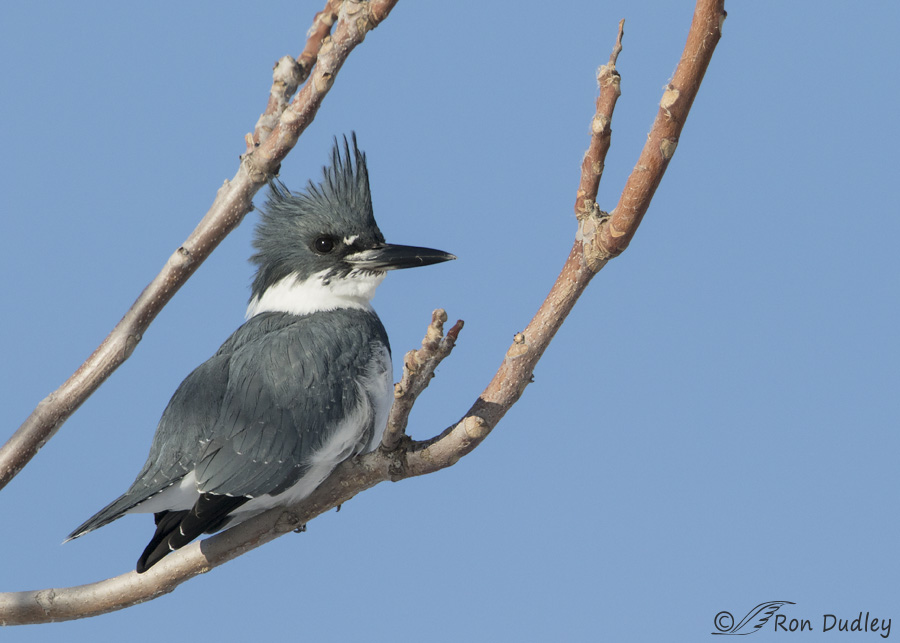
1/3200, f/7.1, ISO 640, Canon 7D Mark II, Canon EF 500mm f/4L IS II USM + EF 1.4 III Extender, not baited, set up or called in
I found my old friend the male Belted Kingfisher on a natural perch this time instead of his favorite wooden post next to the creek. He was still fishing the same creek but from a little further away and higher up.
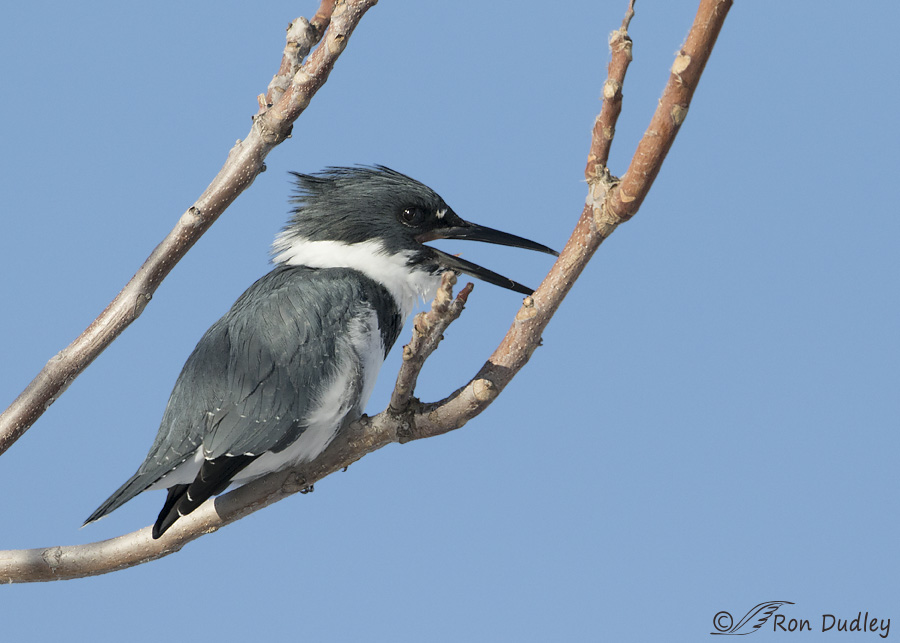
1/3200, f/7.1, ISO 640, Canon 7D Mark II, Canon EF 500mm f/4L IS II USM + EF 1.4 III Extender, not baited, set up or called in
When he started to retch I knew he might throw a pellet so I hoped to get lucky and capture it.
- Some (unsolicited) advice for photographers who may try to document this behavior: When they try to cast a pellet birds typically struggle getting it out so they often retch many, many times before (and if) they’re successful. When the pellet is expelled it usually comes out very fast so you have to be quick and lucky. The danger is that your camera buffer will fill firing bursts during the retching process so you miss the actual pellet when it’s finally expelled. Typically I try to be somewhat judicious with my bursts so I still have some bullets in the breech at the right time. Sometimes it works and sometimes it doesn’t.
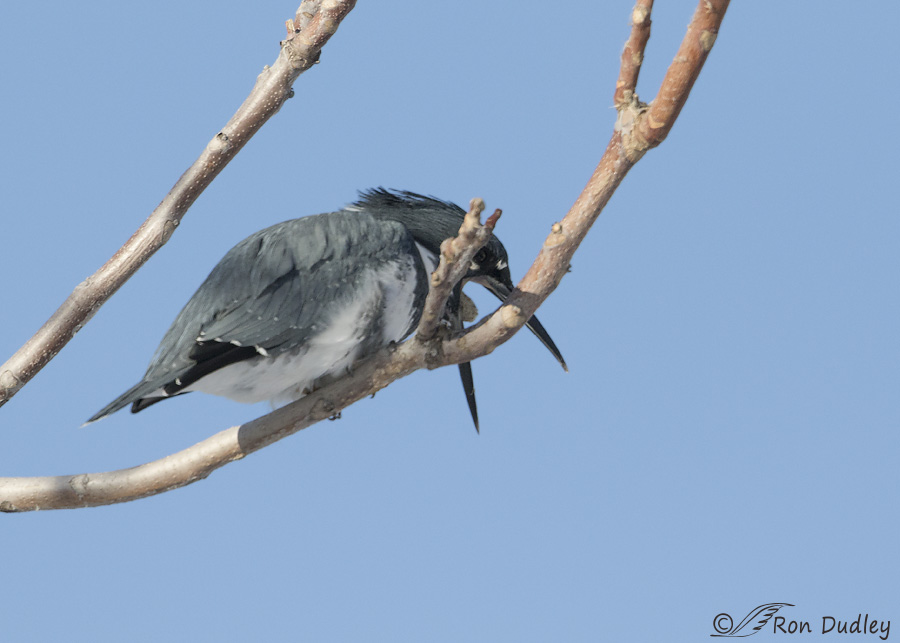
1/3200, f/7.1, ISO 640, Canon 7D Mark II, Canon EF 500mm f/4L IS II USM + EF 1.4 III Extender, not baited, set up or called in
I wish the bird’s head had been on the other side of the branch but the timing worked out so I was still able to see the pellet in each frame. Here we see the pellet at the front of the throat and about to be expelled.
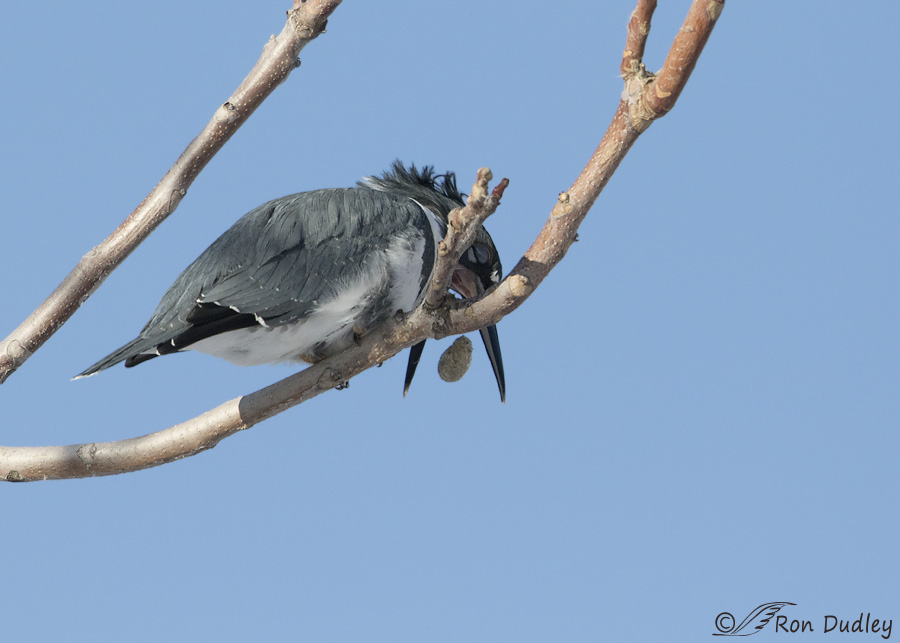
1/3200, f/7.1, ISO 640, Canon 7D Mark II, Canon EF 500mm f/4L IS II USM + EF 1.4 III Extender, not baited, set up or called in
In the next frame the pellet has barely cleared the branch…
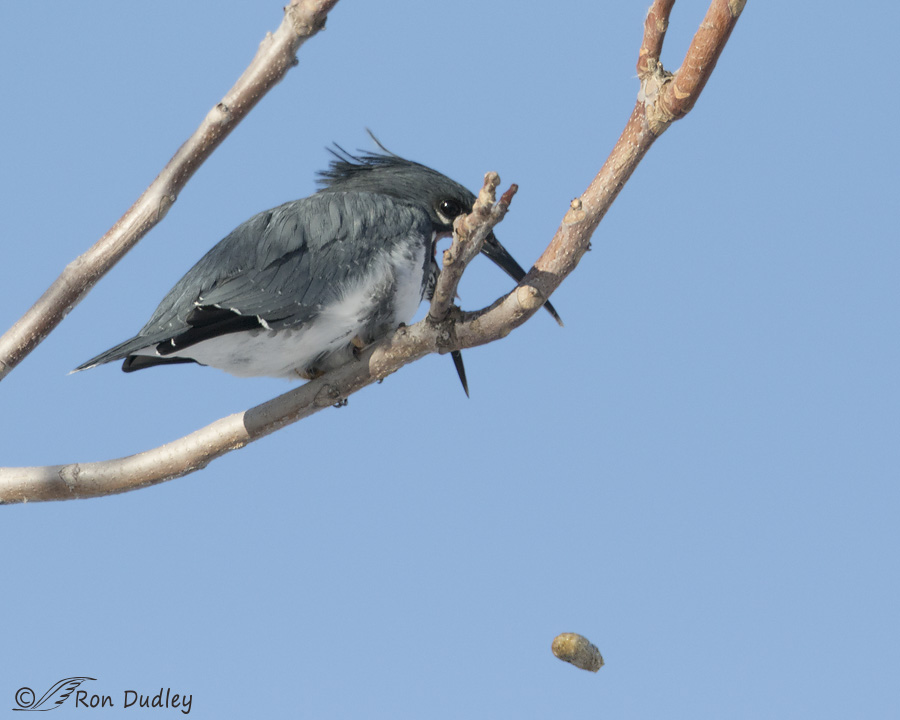
1/3200, f/7.1, ISO 640, Canon 7D Mark II, Canon EF 500mm f/4L IS II USM + EF 1.4 III Extender, not baited, set up or called in
and then it dropped to the ground.
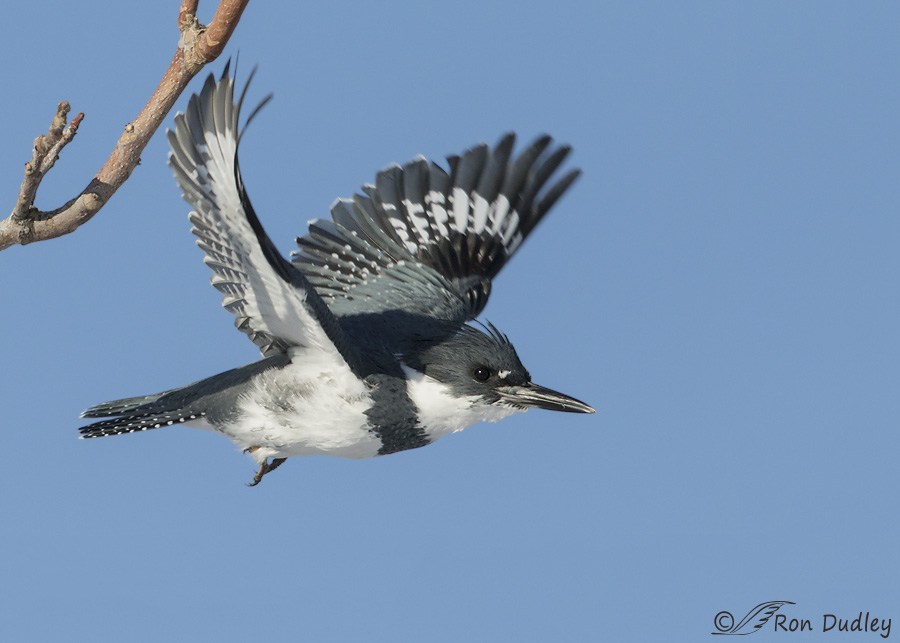
1/3200, f/7.1, ISO 640, Canon 7D Mark II, Canon EF 500mm f/4L IS II USM + EF 1.4 III Extender, canvas added for composition, not baited, set up or called in
After that it didn’t take long for him to take off and…
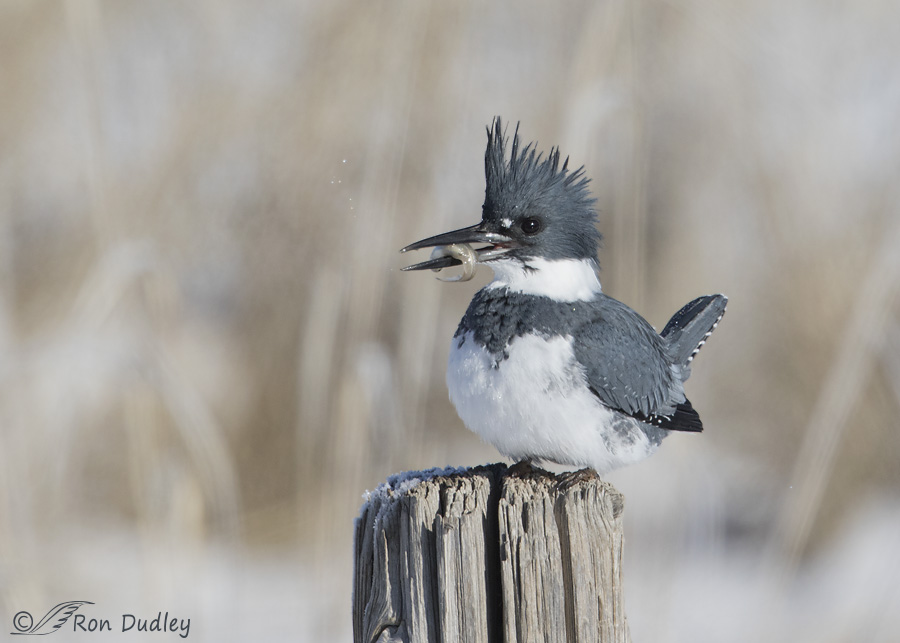
1/2500, f/8, ISO 800, Canon 7D Mark II, Canon EF 500mm f/4L IS II USM + EF 1.4 III Extender, not baited, set up or called in
fish from his favorite perch just over a hundred yards away (I moved my pickup closer to the bird to get this shot). Within just a few minutes he caught two small fish and with this one he landed on a different but nearby post before swallowing it.
Pellet production in this species is interesting and complex. Like most fish-eating birds kingfishers don’t have a crop and their gizzard is unfit for vigorous grinding so adults must produce pellets of indigestible materials like fish scales and bones and expel them. However, kingfisher nestlings can and do digest the scales and bones so they don’t produce pellets until the fledge. This suggests that gastric fluids change from acid to alkaline at the time of fledging.
In addition, researchers can determine the age of fish consumed by kingfishers by counting the growth rings in the scales found in their pellets.
Pretty neat stuff if you ask me…
Ron


Please add me to receive posts of your blog
Dan
Fantastic shots!
I really enjoyed all of them, especially that last one. If you look closely you can even see sparkling water droplets in the air above his bill to the left. And I just love that flight shot!
I hope to see a kingfisher one day (hopefully soon).
Levi
Good eye on those water droplets, Levi. When I was processing that image I left those water droplets in the sharpening mask to make them just a little easier to see. I’m glad you noticed them.
That would DEFINITELY feel better out than in. It is a remarkably big pellet.
Another fascinating behavioural series which I will probably never see. Megathanks. As always.
“That would DEFINITELY feel better out than in”
Yup, that says it all, EC. Thanks.
Ron, you have asked in the last few days if we had any problems viewing the photos. I haven’t previously had any trouble but today the #5 photo is missing. It might just be my computer but I have never missed a photo of yours before. Great pellet shots of your almost trained kingfisher. I keep hoping to get up from Provo to try and find him before he/she leaves for the winter. Thanks for sharing .
Doc Hansen
Doc, my issues with Comcast continue. Most folks aren’t having problems loading my blog but a few are. I hope it clears up soon…
#5 is missing for me too.
Interesting…
Thanks.
Very interesting article Ron. I did not realize that Kingfishers cast pellets. I will keep my eye out for this now. I bet Cornell BNA would love your photos of this behavior.
I find Kingfishers to be a very skittish species to photograph. They always stay very farm away from my vehicle, and they let out their alarm call once they see me. Do you find them to be skittish at Farmington Bay?
Ed, I think all Kingfishers are unusually skittish by nature. But occasionally, when the best food source (pond or creek) is close to traffic, a bird will become acclimated to vehicles and allow a close approach. That’s the case with this male and the female I’ve been photographing over the past year at a pond near my home.
What a terrific series with a favorite of mine, Ron!! All the photos are amazing and I know you remember my telling you about the Owl pellet dissection I got to do at a Green Cay lecture. However, there is nothing like seeing one of those huge pellet’s, for the size of the bird, having to be cast. Isn’t it true that they can’t eat until they can expel the pellet!! Thanks again for a terrific behavioral series!!
“Isn’t it true that they can’t eat until they can expel the pellet”
That seems to be a logical presumption, Jo Ann, but I can’t confirm that it’s always true.
I don’t think they CAN’T eat before throwing a casting, but I know that they’re a lot more excited to hunt/eat after casting.
Sorry for the late response. I’ve been in computer hell AND without Internet for the last week while looking for my forever home in Kingman, AZ. I think I found it, but now, I’m catching up on email and everything else.
Wonderful series. I especially like the last shot, because of the tail position – it reminds me of Wrens. As always, seeing a Kingfisher makes me smile.
You’re right, Susan – that tail posture IS similar to wrens.
Wonderful capture, tremendous behavioral series, great job!!
The picture of the pellet dropping to the ground did not show up on my screen, all the other pictures did.
Dick, Yes, my problems with Comcast are ongoing. Most folks aren’t having problems but some are and it’s very frustrating for all concerned, including me!
You are a terrific teacher. I loved today’s lesson and photo documentation. Getting a series like this isn’t easy but you seem to manage to do it on a regular basis. Your blog is one of the joys I look forward to every day.
Dennis, what you said in your comment meant a lot to me this morning. Thanks!
This is so true Dennis. Lately I try to avoid looking at the “news” and instead look forward to Ron’s blog article each day. The beautiful photos and the educational material that Ron posts are a great way to start my day. Thank you Ron for all you do here!
Fascinating! I had no idea that adults produced pellets and nestlings did not. I’m happy that your buddy is sticking around! (Did you name him? I have a memory like a sieve.) I appreciate the photography lesson too — I would have put my finger on the button and let ‘er rip, so would have missed the money shot.
Mitch, thanks for the comment about the tongue. I went “Where’s Waldoing” and was able to see the tip in the last pellet shot as well.
Nope, haven’t named him, Marty – other than some not very kind names I’ve called him at times when he’s DELIBERATELY! taken flight when I was distracted for a nanosecond.
Loved your “Where’s Waldoing”!
Ooooh, I can imagine those names! 😉
What Mitch (a very wise person) said! This is a spectacular series of shots (insert the string of OH WOW superlatives here) and look what could have been lost in your (usual) persnicketyness could have lost 🙂 Just poking your Perfectionist Self (I’ve got that self, too).
Seriously, this is an outstanding series of shots and behavioral explanations. How amazing that the kids CAN digest all that. So many wondrous adaptations for survival. I find it equally amazing that brand new hatchling hawks who have only been on this planet (out of the egg) for a matter of hours, know to aim their little behinds off the side of the nest. So many more cool things about birds.
And those rockin’ head feathers! YAY Kingfishers!
Thank you, Laura. Makes one curious to know how many wondrous things we’ve yet to learn about birds, doesn’t it?
Oh there’s SO much more to learn. I love that about life! Such wondrous intricacy and raw beauty!
Laura, I agree with you about the hatchlings knowing instinctively what to do. I started watching the Berry eagles nest in 2014 and just loved seeing the hatchlings back up to the side of the nest and letting it rip!!! Of course the tree branches surrounding the nest looked like they had been white-washed – LOL!! I liked to call that behavior their “Point and Shoot”!! Just love watching our wonderful wildlife and so happy to be retied so I can do more of it!!
Retired is a GOOD thing, isn’t it Jo Ann!? Finally we have time to do all those cool things we wanted to do but couldn’t with those pesky job thingies!
Always learning!!! Would have never guessed always figured the pellets were hair and feather balls but I guess not exactly!! A hundred yards!!! I really need to sen my rig in .!But waiting for after holidays. Got a package from ups this week and it was a beat up mess!!! Very jealous of your king Fischer pictures !!! I’m closer yet my pictures aren’t as good. Pond is almost froze solid so kingfisher has moved to the river.
Marina, you misunderstand. I wasn’t a hundred yards from the bird when I took that shot. I moved my pickup much closer to the bird to get it. The misunderstanding is probably my fault, I should have been more clear (I’ll edit my post to clear it up). Sorry about that.
Awesome behavioral shots Ron!!
Charlotte
Thank you, Charlotte.
Great series. And thank you for the “unsolicited” advice as well as the other information. Very interesting and useful.
Glad to see that the 7D Mark II is back on track again.
Thanks, Jorge. The gear problems I’m having are (once again) intermittent so I’m still not sure if it’s the camera(s) or the lens. I’m getting sick of it all.
Hey, Ron–For years, I set my personal standards so high on wildlife shots that I had almost nothing to show friends and family, and had sent way too many to the black hole of “delete”. Photography became a lot more fun when I started looking for what’s “right” in a shot as opposed to the the myriad of things that can be “wrong”. These guys don’t pick a perch with a perfect background and nothing between you and the bird; in my experience, that’s a very rare occurrence.
For instance, in the second shot of this sequence, you can just see the tip of the Kingfisher’s tongue. That alone makes it a killer shot according to my “new” critical criteria. 🙂
As always, very good work, and excellent documentation. Best…Mitch
Thanks, Mitch. If I remember correctly, in other shots of this bird retching his tongue is even more apparent.
Beautiful shots and VERY interesting, Ron! 🙂 Think I’d gag on something that size relative to me also! I was unaware then, and other fish eating birds did that. Always something to learn. 🙂 I can see where the buffer would fill up shooting many shots to get “the one”. Thx for lesson in biology AND photography. 🙂
Judy, they often DO gag during the process – that’s what the retching is all about. I once documented a harrier that retched and gagged so strenuously during the process that it actually fell off the perch it was on. It barely recovered in time.